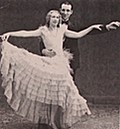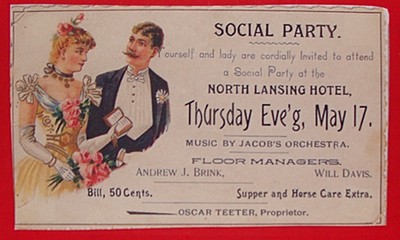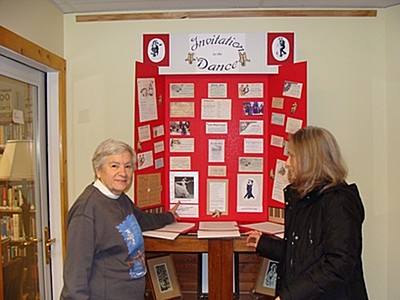- By Dan Veaner
- Around Town
 Print
Print  'Invitation to the Dance', the third in a recent series of Lansing historical exhibits features local dances in the mid to late 1800s. The exhibit features invitations that are really advertisements for local dances centered mainly around North Lansing. The cards give a taste of what local entertainment was like, featuring dances of the time, dinner, and live orchestras. The exhibit is open now in the downstairs gallery at the Lansing Community Library.
'Invitation to the Dance', the third in a recent series of Lansing historical exhibits features local dances in the mid to late 1800s. The exhibit features invitations that are really advertisements for local dances centered mainly around North Lansing. The cards give a taste of what local entertainment was like, featuring dances of the time, dinner, and live orchestras. The exhibit is open now in the downstairs gallery at the Lansing Community Library."My Dad would tell about going to the dances," Says Lansing Town Historian Louise Bement. "He said when you were done at night you would just get on your horse and go to sleep because the horse knew the way home. You curried your horse, then changed out of your dance clothes and went to milk the cows."
While leafing through folders in the town archive Bement had the idea for the exhibit, then Fannie Welsh began researching and putting it together. Some of the cards advertise dances at the North Lansing grange hall, which was demolished only a few years ago. Many of the cards advertised dances at a hotel in North Lansing, which is long gone.
"It changed names," Welsh notes. "It was the Smith Hotel, the Learns Hotel, it was Howser's... it changed hands several times. It was up at the four corners in North Lansing."
 The Rogue's Harbor Inn ballroom is not changed much from the way it was in the 1800s
The Rogue's Harbor Inn ballroom is not changed much from the way it was in the 1800sThe oldest invitation advertises a dance at Rogue's Harbor in 1855 when South Lansing was known as Libertyville. The ballroom on the third floor of the inn was reopened in December of 2008, largely intact. It was specially constructed with an arched ceiling and a special dance floor.
"The Rogue's harbor ballroom upstairs has a spring floor," Bement explains. "A spring floor is like a spring wagon, it isn't coiled springs. That was to protect the building, because when everyone danced in unison it would rock the building like a bridge when people would march over it. To protect the building the floor had to give a little."
Masks and costumes were available to rent or buy at some dances. Floor managers filled the role of bouncer, and one invitation says you won't be admitted without a lady. In the North Lansing Grange Hall dinner and dancing would set you back $1.00. At Smith's Hotel dancing cost 50 cents, but supper and horse care was extra.

"The people who would go to the dances would do all their chores, then go out to dance after supper, and they'd take their children with them," Bement says. "The children would be bedded down all around the grange hall or Bush's Hotel, a tavern in Lakeridge."
Dances of the day included the Quadrille, Money Musk, Lancers, Waltz, Caladonians, Portland Fancy, Opera Rest, Two Step Waltz, Sarainga Lanciers, Paddy Carey, and Virginia Reel.
"I found a hundred different dances," Welsh says. "Today they do a lot of these dances at the Bethel Grove Community Center. It's still alive if you want to do it."
 Town historian Louise Bement (left)
Town historian Louise Bement (left)The invitations mark Christmas parties, social parties, a Masonic hop, and other events. The exhibit also acknowledges the Bower School of Dance which was founded in 1934 in Myers. Today it is The Ithaca Academy of Dance. Vern and Irene Castle. Irene's second husband was Robert E. Treman, with whom she lived in what is now the Sigma Kai Fraternity house.
"In Carol Kamen's book I think it said they financed the movies, and unbeknownst to Irene Treman had used her savings," Welsh says. "So she was without any money when she found out. But in a couple of other places it says he lost it in the stock market, which sounds like what a Treman would do!"
Welsh also compiled two recent exhibits on the history of Lansing politics and clothing townspeople wore in the 1900s.
v9i5



